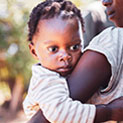- Approfondisci
Cos'è un ready-to-use therapeutic food (RUTF)
Un Ready-to-Use Therapeutic Food (RUTF) è un alimento speciale, poverissimo in acqua, dalle proprietà nutrizionali avanzate. Si presenta come una pasta che è direttamente spremibile in bocca dalla confezione, oppure dispensabile in contenitori dotati di cucchiaino. È un mix di ingredienti che mirano al soddisfacimento dei requisiti nutrizionali dei bambini dai 6 mesi ai 5 anni di età, colpiti dalla Malnutrizione Acuta Severa (MAS): di fatto, si tratta di un insieme di stati patologici connessi ad un insufficiente introito dei nutrienti assunti tramite l’alimentazione. Nella sua accezione classica, il RUTF è composto da arachidi, latte scremato in polvere, olio di palma, olio di colza, lecitina di soia, zucchero impalpabile e un mix di sali minerali e vitamine. Purtroppo, l’elevato costo del latte scremato in polvere incide per più di un terzo sul prezzo totale del prodotto finito. Inoltre, l’intolleranza che presentano i bambini verso il latte dopo l’età dello svezzamento e la sua irreperibilità sui mercati africano e asiatico, rendono la produzione locale del RUTF molto problematica.









